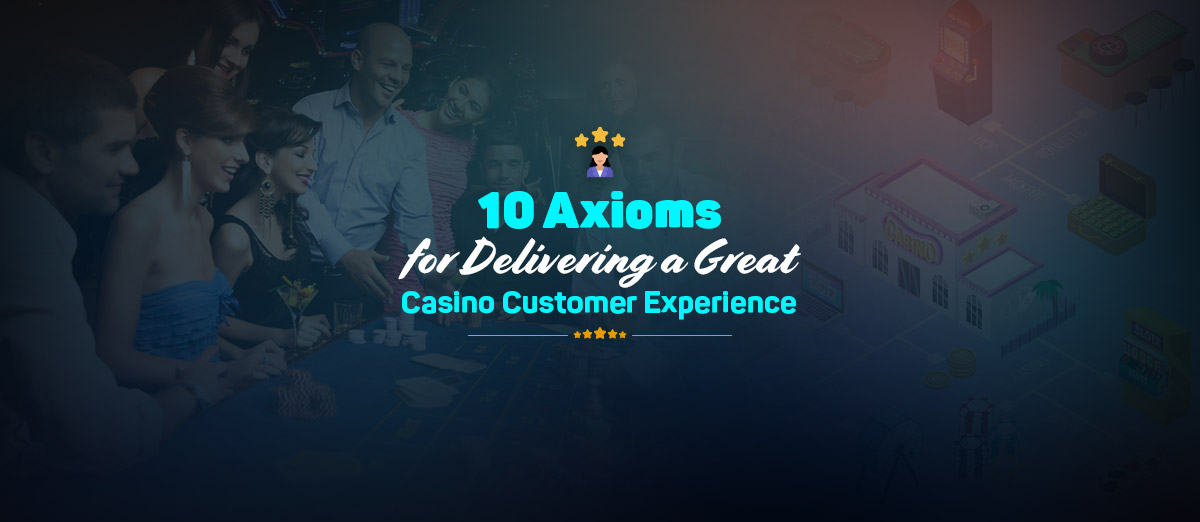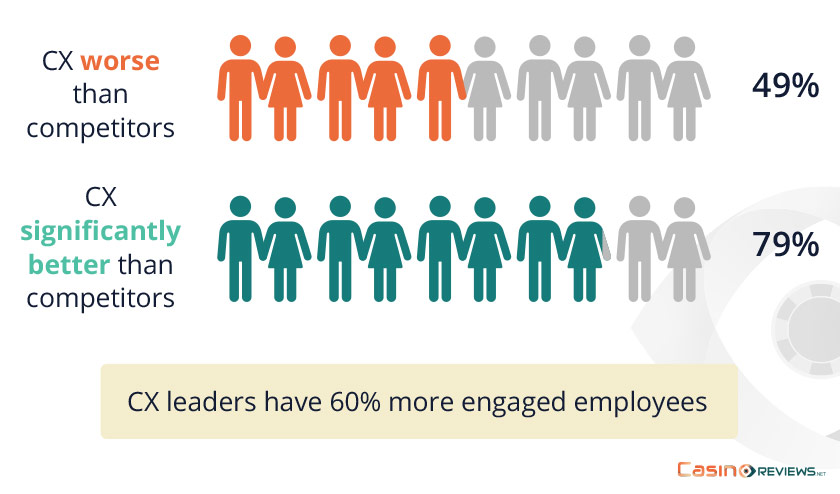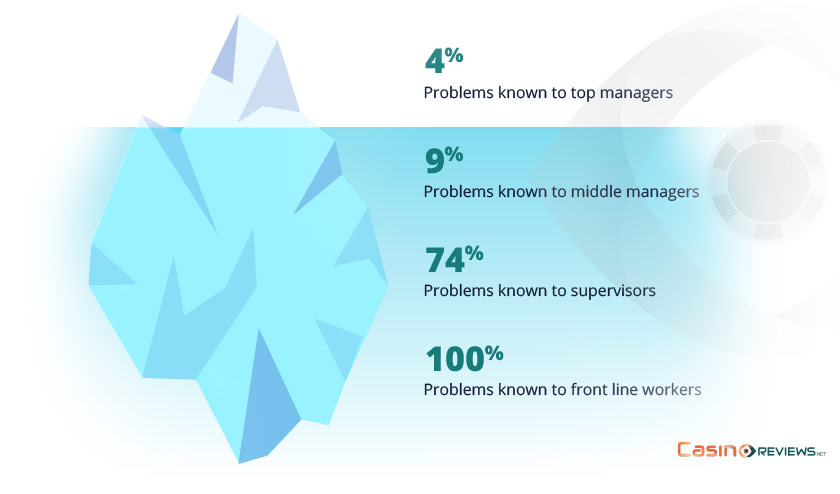Ten Proven Tips for Creating Memorable Customer Experience

Despite increased attention devoted to customer experience (CX), there seems to be no noticeable improvement in the perceived quality of guest experience delivered within the hospitality industry. The casino industry, in particular, has often faltered in its attempts to provide guests with a satisfactory experience. Delivering a great customer experience is complicated because CX is a multifaceted outcome derived from several factors. This article discusses 10 key axioms to improve CX in casinos.
Introduction
Achieving sustained competitive advantage through excellent customer experience (CX) has become the holy grail for most hospitality businesses. The casino industry is no different. Senior casino executives invariably refer to customer experience in their press interviews and public addresses.
Despite all the talk and fanfare about CX, hardly any casino enterprise actually delivers a great customer experience. Even MGM Resorts, one of the few companies to have appointed a Chief Experience Officer (CXO), flounders when it comes to a consistent and satisfactory end-to-end CX. During one of my stays at Excalibur, an MGM property in Las Vegas, I checked into my room to the horror of finding blood stains on the bedsheets. Then, when I was checking out, I realized that their players' ratings on the casino floor were totally out of whack.
A lot has been written about why CX matters and about its significant positive impact on revenues, profitability, and customer retention. As markets in most geographies begin to recover from the COVID-19 pandemic, casino operators need to get serious about pivoting their customer experience to align it with new market realities and elevated customer expectations. In markets such as Macau, recovery is modest to non-existent at best.
Most casino executives operating in Macau had become so accustomed to the "build it, and they will come" proposition that a significant overhaul of their operating ethos alone can save them from the ravages of COVID and the never-ending squeeze on Chinese players by Mainland authorities. Customers now need to be viewed from the fresh lens of customer-centricity, and CX should form the cornerstone of all marketing initiatives.
While markets such as the Philippines and the United States are faring better compared to Macau, they will be facing increasing competition from newer properties and those that are currently being constructed. Customer acquisition and retention, regardless of geography, will now increasingly be dictated by the quality of guest experience. This article offers ten proven prescriptions for enhancing CX.
Customer Experience - Ten Indomitable Prescriptions
- Lead with a Mission
Customer experience delivery involves an integrated approach to understanding and delivering on the customer's stated as well as implicit needs. Uncovering customer needs and preferences requires the casino provider to be market-oriented.
Delivering a customer experience based on uncovered customer needs requires a customer-centric orientation across various units and departments. CX excellence is thus predicated by an organization-wide commitment to market orientation and customer-centricity. However, market orientation and customer centricity form a mere substratum of a compelling CX program. To deliver meaningful business impact, CX leaders must have a documented mission and a well-articulated strategy for their CX program.
The mission and strategy need to be propagated across the organization so that every department is aware of what experience is promised to the customer and how it is to be delivered. Furthermore, the mission and strategy require unqualified buy-in from the entire C-suite.
- Start and End with People
The land-based casino industry has been facing stiff competition from online operators, particularly since the onset of COVID-19. Online providers have lower costs and can therefore afford to spend more on player reinvestment initiatives. It is easier to collect and analyze player data for online operators than it is for land-based casinos. Find more thorough comparison between the two forms of gambling in land-based vs online casinos blog post.
The one area where land-based casinos can differentiate themselves from their online counterparts is people. "People" implies suppliers, consultants, employees, and customers. All humans across these four constituencies have a significant impact on the customer experience. I can pretty much assess the quality of experience a casino operator provides by looking at how the casino treats its suppliers or consultants.i
- Map the Entire Customer Journey
In interacting with the casino provider, a customer typically encounters several touchpoints which collectively define the customer experience. The customer journey comprises all customer-decision-making stages and company interactions, and customer experiences in the course of a visit. Typically, CX providers try to capture the customer's journey by designing a customer journey map.
According to Salesforce, 56% of companies with 2,500+ employees have adopted a "customer journey strategy" — but just 29% rate their strategies as "very effective" or "effective.ii" Mapping out the customer journey enables businesses to step into the shoes of their customers and experience their service from the customer's perspective.
Mapping the customer journey begins with creating customer personas. A customer persona is a generalized representation of your typical customer. Customer personas shed light on who the customer is, what their desires and expectations are, and what they expect at various touchpoints. The customer journey map ensures a solid understanding of the customer persona and facilitates the delivery of the desired customer experience.
- Harness the Potential of Artificial Intelligence
Most casinos rely on conventional methodologies such as customer surveys and regression-based analytical techniques for their Voice of Customer (VoC) insights. Mining insights across billions of customer journeys and data points using conventional analytics strategies and tools is a slow and tedious process. Artificial Intelligence (AI) technology, on the other hand, enables casino operators to continuously enhance their understanding of each individual customer across thousands of data points with every interaction.
Such 360-degree customer understanding makes it possible to orchestrate each touchpoint along the customer journey based on each customer's desires and preferences. The customer is no longer provided with a generic offer based on the segment they fall into. Rather, we now have a "segment of one" with the potential for hyper-personalization at each touchpoint.
- Engage the Entire Organization
Earlier, we alluded to the role of people in providing the desired customer experience. Casino's employees form the most important segment of the "people" component. Employees in an integrated casino resort are the public face of the organization; they're the casino's brand ambassadors. They play a vital role in the design and delivery of the customer experience. According to McKinsey & Company, 70% of customers base the quality of their experience on how they feel they are being treated by the seller's employees.iii
Casino employees are often overworked, understaffed, ill-trained, and poorly resourced. For delivering a great customer experience, employees—especially frontline employees—need to be fully engaged with their jobs and with their workplace. Gallup defines employee engagement as, "the involvement and enthusiasm of employees in their work and the workplace."
Similarly, Aon Hewitt defines employee engagement as "the level of employees' psychological investment in their organization." Employees engaged with their job exert discretionary effort to achieve organizational goals and enhance customer satisfaction. They tend to stay longer with their employer and are strong advocates of the employer's brand.
While the order of importance of individual factors contributing to employee engagement may vary from one year to another or from country to country, the key drivers of employee engagement don't change.
These are: employee rewards and recognition, senior leadership, career opportunities, the employee value proposition, and enabling infrastructure. The Temkin Group found that CX leaders (companies offering a significantly better CX than their competitors) tend to have 60 percent more engaged employees (See Figure 1).

Figure 1: Link Between Employee Engagement and CX (Source: The Temkin Group, 2017)
- Decimate Organizational Silos
Organizational silos are social structures that divide a company's employees into groups based on departments, rank within the company, geographic location, or work schedules. While silos may enhance intradepartmental or managerial-level cooperation and camaraderie, they often impede the free flow of data, information, and ideas across the organization. Customer experience is a team sport, and several departments' inputs come into play at each customer touchpoint. Silos often result in an "us vs. them" orientation resulting in toxic competition and petty rivalries among groups at the expense of organizational well-being and customer satisfaction.
Departments such as Security, Surveillance, I.T., and H.R. often play a role in most customer touchpoints. If these departments operate with a silo mentality, the overall customer experience suffers. Several departments need to work together in unison for a seamless guest experience to be delivered. Very often, a large part of the job of the Chief Experience Officer (CXO) is to demolish ensconced silos and sow the seeds of collaboration across departments. While it may not be feasible to get rid of silos in their entirety, it is possible to create functional stovepipes across silos so that ideas, data, and information can flow freely.
- Focus on Customer Lifetime Value
Very often, casino companies tend to focus on individual transactions with customers as opposed to their lifetime value to the organization. A transactional approach is myopic and does not capture the entire potential of a relationship. Rather than focusing on gains or losses in a single transaction, businesses should consider a customer's lifetime value (CLV). CLV is the present value of all the future cash flows attributed to a customer relationship.
Calculating the lifetime value for various segments or even for individual customers will inform casino operators on how much to invest in customers. A young professional customer just starting their career may spend little in a casino right now.
However, their lifetime value to the casino would be significantly greater than a retired pensioner spending equal amounts of money at the present time. If potentially "good" customers are offered a great customer experience right from the start, they will become increasingly loyal as well as profitable with the passage of time. Sadly, the player reinvestment programs of most casinos look only at the average daily theoretical (ADT) and fail to grasp the total value of a customer.
- Seek Out and Act on Employee Feedback
You may have heard about the "Iceberg of Ignorance," a term coined by Sidney Yoshida in 1989iv. Yoshida argues that frontline workers in a company are aware of almost 100 percent of the problems the business faces, while top management is aware of only four percent of the problems. Supervisors, according to Yoshida, are aware of 74 percent of the problems (see Figure 1). These statistics definitely ring true when it comes to problems faced by customers or the problems faced by frontline staff in dealing with customers.

Figure 2: Yoshida's Iceberg of Ignorance
Not many senior executives in the casino industry are aware of the happenings on the gaming floor. In fact, given the location of their offices, many senior executives may not have seen a single customer in their flesh and blood. Consequently, they are mostly ignorant of the day-to-day problems faced by customers and the service staff. Executives' gestures of customer intimacy are often limited to shaking hands with a few customers at New Years' Parties and distributing prizes at casino tournaments.
When first-hand feedback on customer issues is lacking, it behooves casino management to actively solicit and act upon the feedback received from their staff, particularly from frontline employees. An open-door policy toward employees or conducting regular town-hall meetings with all staff are excellent ways of gathering information about customers and customer service. Acting on employee feedback will improve not only the customer experience but also enhance the employee experience.
- Link Employee Rewards to Customer Satisfaction
Several research studies have established that customers' interactions with employees are the single most important determinant of customer satisfaction. Oftentimes, businesses conduct focus groups or customer satisfaction studies to assess how employees are performing in the eyes of their customers.
However, employees receiving positive mentions are seldom acknowledged or incentivized. One way to ensure congruence between employee rewards and CX is to link employee bonuses to CX metrics. The choice of incentives provided to employees also matters. In most societies, workers value those rewards that enhance their work-life balance.
Financial incentives, unto themselves, seldom reinforce desired long-term behaviors. The GAP stores in the United States, for instance, saw a huge increase in the sales of those stores where employees were given stable and predictable shift work. A routine in working hours allowed GAP employees to better organize their non-working hours around family and friends. This kind of reward assumed precedence over overtime payments.
- Design and Apply Service Blueprints for Delivering a Great CX
While I have written a lot about service blueprints in different media outlets, not mentioning them here would be a grievous omission. A service blueprint is a service roadmap—a tangible, visual document that describes where and how customers interact with our company.
A blueprint is not to be confused with the customer journey map, as the Ethology Agency's Website explains. "If journey mapping is an examination of your customer's experience, then blueprinting is a deep dive into the components that could make that experience the best it can be. Once you have an in-depth and comprehensive understanding of your customer's journey, it's time to look at how you can improve that journey and what your company can do to exceed expectations." In other words, the service blueprint begins where the customer journey map ends.
The service blueprint maps all relevant touchpoints that encompass the customer's interactions with the company. Each touchpoint is defined by five components: the customer's expected behavior, the contact employee's behavior that the customer gets to see (frontstage behavior), the contact employee's behavior that the customer does not get to see (backstage behavior), the support systems and staff needed at the touchpoint, and the physical cues the customer witnesses at the touchpoint.
Once a casino operator has designed a service blueprint, it can be utilized in many different ways. Each employee can now understand how their role fits into the integrated whole. Blueprints can be used to better understand interdepartmental dependencies. They can be used for identifying fail points in service delivery and for effective quality control. The casino can use the blueprint to identify touchpoints with which to differentiate itself from the competition (by creating "golden" touchpoints). Above all, a service blueprint depicts the entire customer experience the way a customer would perceive it.
Conclusion
Consumers all over the world are looking less at things and more at experiences to add meaning to their lives. The casino industry is in the business of selling commercial experiences. Customers expect the casino experience to be gratifying and satisfying.
With intensifying global competition amid rising customer expectations, offering a compelling customer experience won't be easy. However, the only proven way to be relevant in the experience economy is to offer a captivating guest experience. The ten prescriptions offered in this article will enable casino operators to use CX as their source of sustainable competitive advantage.
iKale, Sudhir (2017), “Casino Vendor: Canary in the Casino Gold Mine”
iiHughes, Jonathan, David Chapnick, Isaac Block, and Saptak Ray (2021), “What Is Customer-Centricity and Why A service blueprint is a service roadmap—a tangible, visual document that describes where and how customers interact with our company.
iiiBeaujean, Marc, Jonathan Davidson, and Stacey Madge (2006), “The ‘Moment of Truth’ in Customer Service,” The McKinsey Quarterly, 1, 63-73.
ivYoshida, Sidney (1989), “Quality improvement and TQC Management at Calsonic in Japan and Overseas.” Paper presented at The Second International Quality Symposium, Mexico City.





Review this Blog
Leave a Comment
User Comments
comments for Ten Proven Tips for Creating Memorable Customer Experience